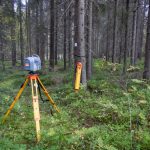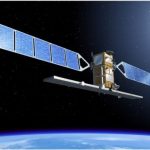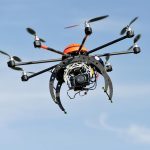Sensors
Many different sensors can be used to acquire information remotely, and they all might be denoted remote sensing. The most common sensors are:

Terrestrial Laser Scanner
Laser scanner. Can be mounted on airborne (ALS) platforms or used on the ground (terrestrial, TLS) or backpacks (mobile, MLS). Common wavelengths are 1,064 or 1,550 nm, and hence belong to the optical spectrum.

Sentinel-1 satellite from ESA. Courtesy ESA.
Synthetic Aperture Radar (SAR). An active sensor normally located on satellites, that emits a single wavelength in the microwave spectrum, e.g. 23 cm (L-band SAR).
Cameras. Can be located both on the ground, drones, airplanes, helicopters and satellites. Can acquire ranges of wavelengths (so called bands) within the near-optical spectrum (~300 nm up to 3,000 nm) and they are dependent on external illumination sources, e.g. the sun. They acquire for example red green and blue colors, but some cameras can also register thermal radiation – heat – and hence see through fire smoke or detect living animals during night time.


